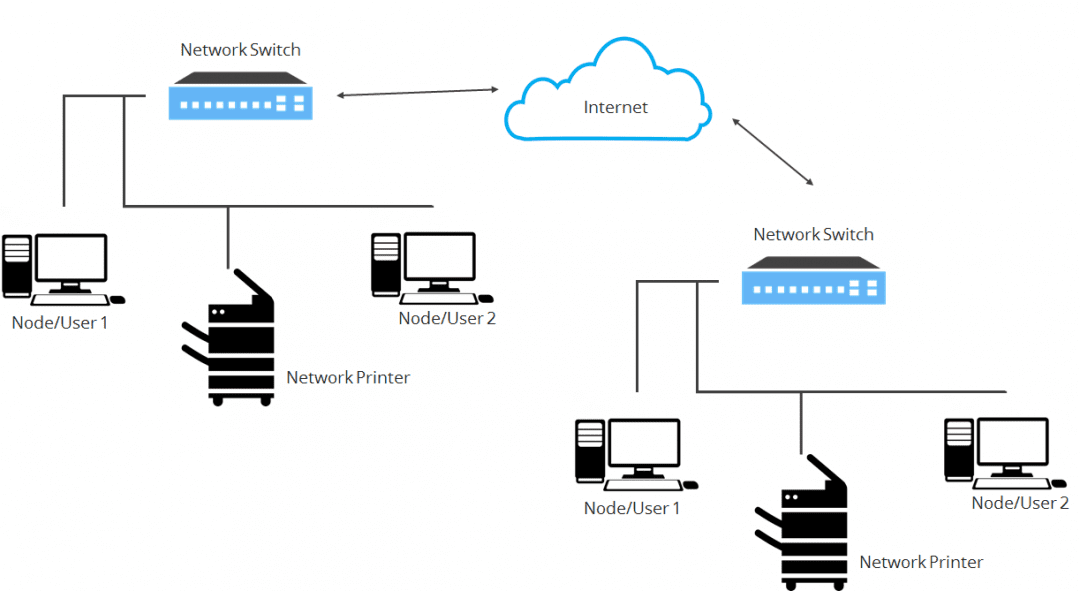Part 1 of 5: Introduction to Networking
- Megan
- Latest News
- 0 likes
- 2656 views
- 0 comments
Welcome to the first part of the series introduction to networking. The aim of this blog series is to provide you with the fundamental knowledge required when building networks.
What is the function of a network?
The functionality of a network is to connect stations, users or nodes on one network to share resources, whether these resources refer to internet access, file sharing or printers and scanners, all users connected to this network will share the resources.
What are the different types of networks?
Well, first, let’s start with the basic, a LAN or Local Area Network. A LAN network refers to the network that is limited to an office building, or a single department or even a home office and refers to the physical connection between the different devices using LAN/Ethernet Cables.

In this scenario, we have two separate LAN Networks, however, user 1 and user 4 cannot share resources as there is no connection between the two networks.
To overcome this problem, you can add a router. A router allows traffic to be routed between two different networks.

A WAN Network is a Wide Area Network, and the easiest example used to describe a WAN is the internet. A WAN network spans large areas and employs both routers and public links.

A VPN refers to a Virtual private network and is a method used to add security and privacy to private and or public networks, like Wi-Fi hotspots and the internet. VPN’s are most often used by corporations to protect sensitive data.

As Networks are all about communication, how does it actually working within a network? This is where the OSI Model is used.
The OSI or Open System Interconnection model is a network map that was originally developed as a universal standard for creating networks.
The OSI Model is divided into 7 Layers

The Physical Layer:
The physical layer refers to electrical and physical aspects of devices. In particular, it specifies how a device sends and receives information, such as using copper wires or fiber-optic cables. Examples of this include Ethernet or fiber optic cables, phone cords used for dial-up or DSL services, the coaxial cable used to provide broadband internet, the wires used to connect various components of a computer or even the radio signals used in wireless communication. Other functions of the physical layer include the conversion of signals into something that another layer can use (referred to as a bit), and adjusting the signal to allow for multiple users to use the same connection.
Data Link Layer:
The Data Layer is mainly the method in which information from the network is broken down into frames and transmitted over the physical layer. This layer is also responsible for some Error detection and correction and some addressing so different devices can tell each other apart in larger systems.
Network Layer:
The Routing Layer works to coordinate related parts of a data conversation to ensure that large files are transferred. In other words, while the data link layer deals with the method in which the physical layer is used to transfer data, the network layer deals with organizing that data for transfer and reassembly. This layer also handles aspects of Routing Protocols, finding the available [best] path(s) from one network to another to ensure delivery of the data.
Transport Layer:
The Transport Layer is the level at which system reliability and quality are ensured. This layer manages traffic flow through the network layer to reduce congestion on a network and performs error checking ensuring quality of service by resending data when data has been corrupted. Some of the most popular methods of encryption and firewall security take place on this layer.
The same as your house has a physical address, so does each device connected to a network need to have an address and this is known as IP addresses, which can either be static, assigned by the user or a DHCP address – an address dynamically assigned by the router device.
In the next part of our blog series, our focus will be on IP Addressing in a network.


Comments
View Comments